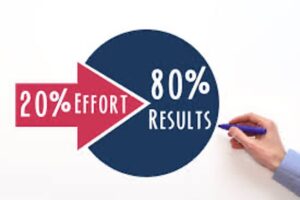The Pareto Principle in Action
Knowing Where Your Profits Come From

My three days at Courtomer (see “Notes from My Journal,” above) was great on several levels.
After more than ten years away from it, I got to see the chateau that I knew from way back in its current state – as a beautiful and comfortable country retreat for business events and family reunions.
I reconnected with 35 or 40 colleagues I rarely see these days because they are working from remote outposts in Europe and the Far East. I was reminded that despite the immensely valuable tool that Zoom is, there is nothing quite like spending time with people with bodies.
I’m on a bus now headed back to Paris and my brain is buzzing with new ideas, as well as great old ideas I’d somehow forgotten.
One of these ideas came from Rory Sutherland, a senior exec at Ogilvy & Mather and a much beloved advertising expert who is frequently on talk shows about business in the UK.
We were talking about market testing – i.e., running several different ads simultaneously in different media to see which version is strongest. Rory said that he follows what he calls the 70/20/10 rule – i.e., that in developing marketing plans for clients, he allocates 70% of the marketing budget towards existing ads that are working, 20% to ads that are new and different but only marginally, and 10% to ads that are far away from what has traditionally worked to see if there might be some new appetite out there in the market that has not yet been discovered.
I think that’s a very smart allocation model – giving the business (and the marketing department) a good chance to make incremental improvements and a remote but still possible chance to make radical improvements, but without risking taking a beating on the bottom line.
I also like the idea because a similar ratio has occurred to me many times when discussing the Pareto Principle – the justly famous idea that in almost any endeavor, 80% of the positive outcomes arrive from 20% of the inputs.
I love the Pareto Principle because of its simplicity. (I’ve been using it since I discovered it because it’s so widely applicable and so often transformative.) Many times, when thinking about how it applies to profits, I’ve come to a similar conclusion – except my ratio is 80, 15, and 5. Twenty percent of the effort made will indeed create 80% of the profits. But if you look more closely at that 20%, you’ll find that 50% of the 80% comes from just 5% of the input.
